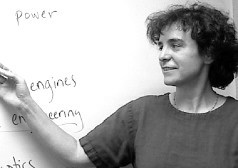Should discussions of moral principles form part of the curriculum in public schools? Katherine Simon '85 has been thinking about this for a long time. The former high-school English and drama teacher recalls how she used to approach Macbeth: by having her students study vocabulary and figures of speech, and pound out the rhythm of iambic pentameter on their desks. They focused on words and structures rather than the play's "existential core." How did her students respond to Macbeth's statement that life "is a tale/Told by an idiot, full of sound and fury/signifying nothing?" Simon didn't ask. "I was neither equipped nor expected to explore questions about what it means to be human," she says, "so our discussion stayed safely out of the realm of morals and meaning." The suspicion grew on her that she was "not teaching what matters."
 |
| Katherine Simon believes in "teaching what matters." |
| Photo by Francisco Orozco |
Simon, who left teaching to earn a Ph.D. in education from Stanford, now directs research for the Coalition of Essential Schools, a California group working with affiliated schools around the country to promote higher achievement and humane communities. Her new book, Moral Questions in the Classroom, explores her conviction that "teachers should be integrating moral matters into their curriculum." Can teachers cover moral questions and not neglect the intellectual content of their courses? Can they do so without teaching religion, and while honoring cultural and religious pluralism? Simon answers these questions with an emphatic yes.
Her undergraduate experience, she says, gave her an excellent basis for thinking about what makes for high quality in education. Literature, her field of concentration, was new, with small enrollments and faculty interested in innovative teaching. "My junior and senior tutorials," she recalls, "were models for intellectually and morally charged discussions on socially controversial issues." Researching the book, she notes wryly, was a lot like going back to high school; she spent hours in classrooms, seeking out teachers who addressed moral issues and analyzing how they engaged students while pushing them intellectually.
Some of the book's most gripping passages reproduce real discussions. One follows a history class on war and morality:
[Teacher]: So let me see....Killing six-month-old people is a war crime.
Zeke: Six months and twelve months and three years and....
[Teacher]: Eighteen?
Zeke: Yeah.
[Teacher]: Why? They are the enemy, aren't they?
Zeke: No, the army is the enemy.
The teacher then prods the student to refine his argument by asking, "What if the soldiers don't wear uniforms?" He sees it as his role, Simon reports, to make his students struggle, to put them into a "kind of agony," in order to clarify their own positions. "All positions are not equal," she notes. "Some opinions stand on more solid intellectual ground than others, and rationality is to be highly prized in arriving at moral positions."
At the end of her book Simon writes about first graders learning about Rosa Parks and the Montgomery bus boycott. "A little girl of mixed European and Asian descent suddenly raised her hand and asked, 'Where would I have sat?' To me, the little girl's question is a perfect metaphor for students' efforts to make meaning of what they learn. They start by asking, 'Given this information, what more do I know about my life? How do I fit into this picture?'" School, Simon suggests, "could be a place where, wrestling with these questions, we begin to make sense of our lives."
~Deborah Schneider




